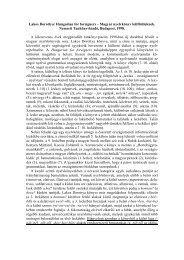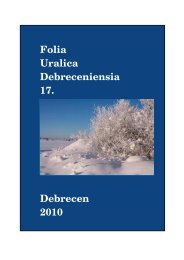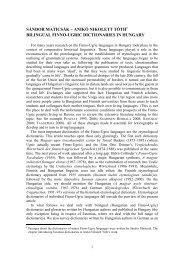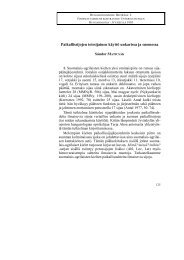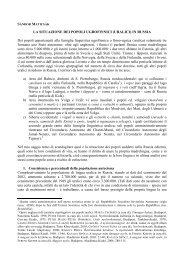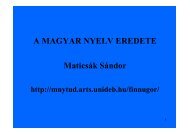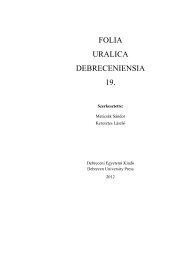This concept is even more curious in the <strong>Erzya</strong> coursebook written by Mosin–Bajuškinpublished in 1983 (47). This book uses Finnish as an intermediary language, but gives the <strong>Erzya</strong>word forms in Cyrillic letters. The authors use the system outlined above for the explanation <strong>of</strong>the linking rules, this is why one can read the following in the description <strong>of</strong> the genitive: „c)sidevokaalin e välityksellä, jos vartalon viimeinen äänne on liudentunut dentaali...”, d)sidevokaalin э välityksellä, jos vartalon viimeinen äänne on liudentumaton dentaali...” 1In his unilingual dictionary <strong>of</strong> definitions published in 2002, Abramov tries to resolve thecontradiction between Cyrillic transcription and the existence <strong>of</strong> palatalized consonants in alogical but peculiar way: кед|ь, - ьсе, -ень, -не. A positive aspect <strong>of</strong> Abramov’s approach is thathe treats the additional vowel in expressly as part <strong>of</strong> the suffix.As regards literature written by foreign linguists: Alo Raun (1988: 100–101) lists the wordforms without the additional vowel (Gen. -ń, Illat. -v and -s, Translat. -ks, Comp. -ška), but as heonly included words ending in a vowel, he got around the problem in effect. The book titledChrestomathia Morduinica partly follows the connective vowel conception – kal ’fish’ : kal-o-ń,keď ’hand’ : keď-e-ń (Gen.); karks ’belt’ : karks-o-ks, piks ’rope’ : piks-e-ks (Translat.) – however,it also applies the stem-final vowel theory to some extent – oš ’town’ : ošo-v, viŕ ’forest’ : viŕe-v(Lat.); karks : karkso-ška (Comp.) (Keresztes 1990: 54–55). In his latest monography (2011: 64–65), László Keresztes treats the vowel in question as part <strong>of</strong> the suffix: kal-oń, keď-eń. EditMészáros also gives preference to the descriptive aspect in her <strong>Mordvin</strong> coursebook (1998: 17, 18,31, 77): mastor ’land, country’ : mastor-oń, lomań ’person’ : lomań-eń (Gen.); oš-ov, viŕ-ev(Lat.); vaz ’calf’ : vaz-oška, ľej ’river’ : ľej-eška (Comp.); ruz ’Russian’ : ruz-oks, šved ’Swedish’: šved-eks (Translat.). The same principle is applied by Gábor Zaicz in his comprehensive essay(1998: 191–194): the vowel belongs to the suffix, cf. viŕ-eń, viŕ-ev.Bartens (1999: 70–73) divides the <strong>nominal</strong> roots into four classes (the second <strong>of</strong> which is onlyrelevant in terms <strong>of</strong> the Moksha dialect). The first group is that <strong>of</strong> the roots ending in a vowel(moda ’land’ : moda-ń Gen.); in the second class, there are Moksha roots which contain a reducedvowel in place <strong>of</strong> the full vowel <strong>of</strong> the <strong>Erzya</strong> forms (E veľe ’village’ : veľe-ń Gen., M veľä : veľəń);the third group contains roots which allow for certain <strong>suffixes</strong> to drop the stem-final vowel(e.g. pargo ’basket’ : park-sto Elat.; this change <strong>of</strong>ten goes together with the devoicing <strong>of</strong> thestem-final consonant); 2 and the fourth class, which is the most interesting for our purposes, is theone that comprises roots ending in a consonant. Bartens follows the same principle as theGrammatika: he takes up the kal- and kalo-, or viŕ- and viŕe- type roots.On the whole, we can say that <strong>Mordvin</strong> linguists and Raija Bartens treat the additional vowelas part <strong>of</strong> the stem and differentiate between two types <strong>of</strong> <strong>nominal</strong> roots, while Hungarianlinguists give preference to the descriptive aspect and consider this vowel as part <strong>of</strong> the suffix(similarly to the changes observable in Hungarian: Proto-Hun. hala : hala-t Acc. > after thedeletion <strong>of</strong> the stem-final vowel: hal-at Acc. hal-ban Iness. etc.)2. There are five distinctive features we must take into consideration when discussing thelinking rules <strong>of</strong> case endings:a) whether the stem ends in a vowel or a consonant;b) whether the stem ends in a single consonant or a consonant cluster;c) whether the vowel in the last syllable palatal or velar;d) whether the stem-final consonant is palatal or non-palatal (s<strong>of</strong>t or hard);e) whether the stem-final consonant is voiced or voiceless.1 [c) an e connective vowel is added when the last sound <strong>of</strong> the stem is s<strong>of</strong>t dental, d) an э connective vowel isadded when the last sound <strong>of</strong> the stem is hard dental]2 In 1993, the new orthographic system reflecting morpheme boundaries made the pando ’hill’ : pando-so formsnormative instead <strong>of</strong> the pando : pand-so, since those do not get shortened. However, syllable deletion is animportant element in the course <strong>of</strong> suffixation.2
I have already examined the relationship <strong>of</strong> stems and case endings in detail in my abovementioned paper (Maticsák 2003: 146–160), therefore only a short survey is given about this topichere.GenLatInessElatProlDatAblAbeTrsComIllata) -V / -C + + – – + (+) (+) + + + –b) -C / -CC – – – – – – (+) – + + –c) -V- pal/vel + + + + – – + + + + –d) -C pal/nonpal + + + + – + + + + + –e) -C v.d/v.less – – – – + – + – – – –The distinctive features do not play equally important roles in the formulation <strong>of</strong> rules: themost significant aspects are the stem-final vowel/consonant oppositions, palatovelar vowelharmony, and consonant harmony (being a unique characteristic <strong>of</strong> <strong>Mordvin</strong>). Stem-finalconsonant clusters and the voiced/voiceless opposition are significantly less relevant factors. It isthe ablative that requires the most distinctive features to be involved, while the fewest aspectsneed to be considered for the illative. Based on these facts, from a descriptive aspect, the <strong>Mordvin</strong><strong>nominal</strong> case endings can be listed as follows (handbooks usually give only the forms that do notinclude the initial vowels):Genitive -ń, -eń, -oń Lative -v, -ev, -ovTranslative -ks, -eks, -oks Comparative -ška, -eška, -oškaInessive -se, -so Elative -ste, -stoProlative -va, -ga, -ka Dative -neń, -ńeńIllative -s Ablative -de/-ďe/-do/-te/-ťe/-toAbessive -vťeme/-vtomo/-teme/-ťeme/-tomo3. The literature on the subject matter direct little attention to the linking rules <strong>of</strong> <strong>derivational</strong><strong>suffixes</strong>. Evsev’ev’s grammar (1963/1931), the first grammatical summary <strong>of</strong> pr<strong>of</strong>essionalcharacter, already discussed <strong>derivational</strong> affixes in a systematic way (38–44), but failed toexamine linking issues, the same way as the handbook titled Grammatika published in 1962 (39–43), and the volume about the <strong>Mordvin</strong> language in Feoktistov’s 1966 series describing thelanguages <strong>of</strong> the former Soviet Union (182–183) did. A more recent handbook, the 1980Grammatika, presented this category in considerably more detail, with abundant material (103–115), but the subject matter the present paper examines was mentioned only in the case <strong>of</strong> one ortwo <strong>suffixes</strong>. The latest <strong>Erzya</strong> descriptive grammar handbook (EK 2000: 35–39) also discussesthis topic in a well-organized fashion, though very briefly, and it does not mention any linkingrules. Serebrennikov writes about questions <strong>of</strong> origin <strong>of</strong> the <strong>derivational</strong> affixes in his <strong>Mordvin</strong>historical grammar (1967: 66–71, 75–79), however, linking issues are missing from here as well.D. V. Cygankin’s monograph (1981) on <strong>nominal</strong> derivation (and <strong>nominal</strong> compounds to a littleextent) touches upon certain problems <strong>of</strong> linking in suffixation, but he either does not direct muchattention to this phenomenon. László Keresztes’s chrestomathy from 1990 (65–67) and his latestcomprehensive book (2011: 122) introduce us into word-formation briefly, in a list-like manner,but the linking rules are not discussed in these works either. The subject is treated in a relativelydetailed way in Raija Bartens’s Finnish language manual (1999: 106–107, 110–111), and differentproblems <strong>of</strong> suffixation are examined in the case <strong>of</strong> a few <strong>of</strong> the <strong>suffixes</strong> described. Edit Mészárosprovides a good summary about <strong>derivational</strong> <strong>suffixes</strong> in her coursebook (1998: 41, 50, 59, 79–80,98–99, 102, 140), and she is the one who does so through a more or less consistent combination <strong>of</strong>descriptive and historical approaches.3



